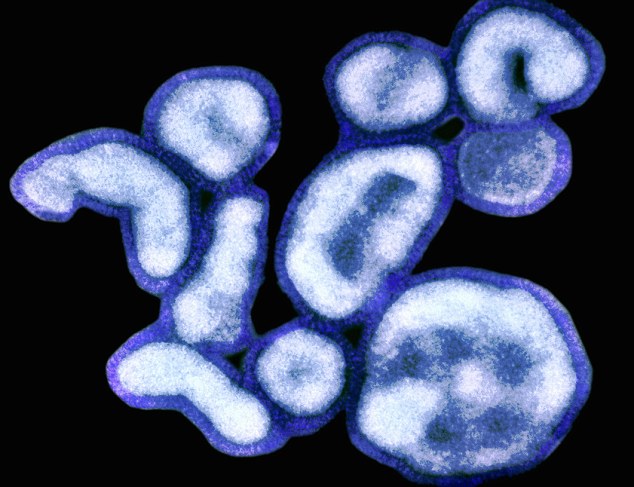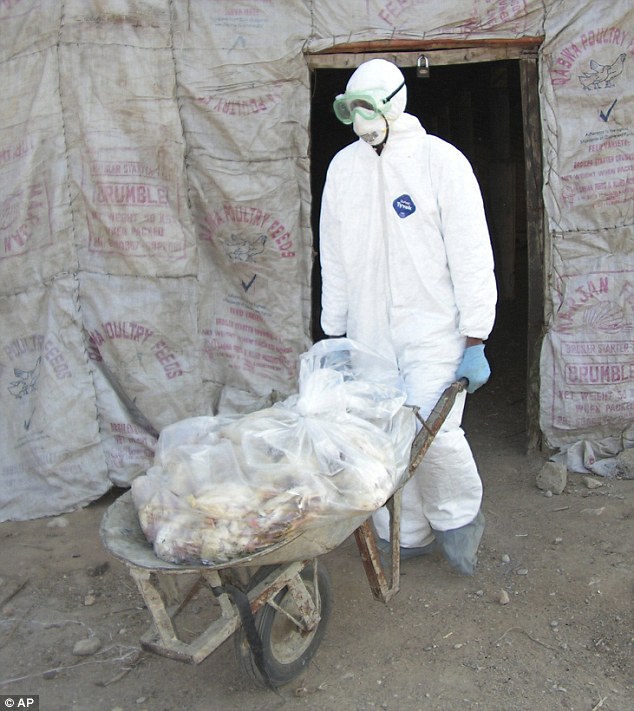Scientists behind Armageddon flu virus suspend research because it “could put the world at risk of a catastrophic pandemic”
Suspension: Ron Fouchier is part of the team of scientists who have ceased their controversial studies on bird flu
Researchers studying a potentially deadlier version of airborne bird flu have suspended their studies over concerns that the mutant virus they created could be used as a devastating form of bioterrorism or accidentally escape from the laboratory.
In a letter published Friday in the journals Nature and Science, 39 scientists defended the research as crucial to public health efforts.
But they are bowing to fear that has become widespread since media reports discussed the studies and their potential consequences in December.
Fears arose that the engineered viruses could escape from laboratories – not unlike the gruesome scenario in the 1971 science fiction film The Andromeda Strain – or possibly be used to create a bioterrorist weapon.
Among the scientists who signed the letter were the leaders of the two teams that led the research, at Erasmus Medical College in the Netherlands and the University of Wisconsin, Madison, as well as influenza experts from institutions ranging from the Centers for Disease Control and Prevention at the University of Hong Kong.
To see the full letter, see below or click HERE.

Fears: Concern that bird flu could escape from laboratories and cause a pandemic or be used in bioterrorism has led to research being halted.
The decision to suspend the research for 60 days “was completely voluntary,” Erasmus virologist Ron Fouchier told Reuters.
The pause in its research is intended to allow global health agencies and governments to weigh the benefits of the research and agree on ways to minimize its risk.
“It’s the right thing to do, given the controversies in the United States,” Fouchier said.

Terror: If it escaped, the mutant virus created by scientists could cause a disaster on a global scale
In December, the US National Biosafety Scientific Advisory Board had asked Science and Nature to redact details of the Erasmus and Wisconsin teams’ research that was submitted for publication.
Biosafety experts fear that a form of the virus transmitted through airborne droplets, which the Erasmus and Wisconsin teams created independently, could spark a pandemic worse than the 1918-19 Spanish flu outbreak that killed to up to 40 million people.
“There is obviously a controversy here about the appropriate balance between risk and benefit,” said virologist Daniel Pérez of the University of Maryland, who signed the letter supporting the moratorium.
“I firmly believe this investigation should continue, but that doesn’t mean a timeout can’t be called.”
The complete open letter
Below is the full open letter from Ron AM Fouchier, Adolfo García-Sastre, Yoshihiro Kawaoka and 36 co-authors. published in the journals Nature and Science on Friday.
‘The continuing threat of an influenza pandemic represents one of the greatest public health challenges. Influenza pandemics are known to be caused by viruses that evolve from animal reservoirs, such as birds and pigs, and can acquire genetic changes that increase their ability to transmit to humans. Pandemic preparedness plans have been implemented around the world to mitigate the impact of influenza pandemics.
A major obstacle in preventing influenza pandemics is that little is known about what makes an influenza virus transmissible in humans. Consequently, the potential pandemic risk associated with different animal influenza viruses cannot be assessed with certainty.
Recent research advances have identified specific determinants of transmission of H5N1 influenza viruses in ferrets. Multiple laboratories around the world conduct responsible research on influenza virus transmission using different animal models using the highest international standards of biosafety and biosecurity practices that effectively prevent the release of transmissible viruses from the laboratory. These standards are closely regulated and supervised by the relevant authorities. This statement is made by the principal researchers of these laboratories.
In two independent studies conducted at two major influenza laboratories at the University of Wisconsin-Madison and Erasmus MC in Rotterdam, the Netherlands, researchers have shown that viruses possessing a hemagglutinin (HA) protein from H5N1 avian influenza viruses highly pathogenic can become transmissible in ferrets. .
This is critical information that improves our understanding of influenza transmission. However, more research is needed to determine how influenza viruses in nature become pandemic threats to humans, so that they can be contained before they gain the ability to transmit from human to human, or so that they can be implement appropriate countermeasures if adaptation to humans occurs.
Despite the positive public health benefits that these studies attempted to provide, the perceived fear that ferret-transmissible H5 HA viruses could escape from laboratories has generated intense public debate in the media about the potential benefits and harms. of this type of research. We would like to assure the public that these experiments have been conducted with appropriate regulatory oversight in secure containment facilities by responsible and highly trained personnel to minimize any risk of accidental release. It cannot be proven whether ferret-adapted flu viruses have the ability to be transmitted from person to person.
We recognize that we and the rest of the scientific community must clearly explain the benefits of this important research and the measures taken to minimize its potential risks. We propose to do so in an international forum in which the scientific community meets to discuss and debate these issues. We realize that organizations and governments around the world need time to find the best solutions to the opportunities and challenges that arise from work.
To allow time for these discussions, we have agreed to a voluntary 60-day pause on any research involving highly pathogenic H5N1 avian influenza viruses leading to the generation of viruses that are more transmissible in mammals. Additionally, during this time no experiments will be performed with live H5N1 or H5 HA recombinant viruses that have already been shown to be transmissible in ferrets. We will continue to evaluate the transmissibility of H5N1 influenza viruses that arise in nature and pose an ongoing threat to human health.’

